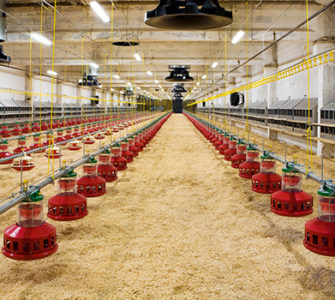NAE production: Helping contract growers navigate maze of new challenges
website builder By Tom Tabler, PhD
Extension Professor
Mississippi State University Extension Service, Poultry Science Department
Mississippi State, Mississippi
“No antibiotics ever” (NAE) production now accounts for nearly 50% of broiler production in the US. Although I personally have grave concerns about the sustainability of NAE production, its rise in popularity might be viewed as a testament to the poultry industry’s openness to consumer trends and willingness to try new production methods.
No one ever said NAE production would be easy, however. It’s created a host of new challenges for contract growers who’ve needed to make an awful lot of adjustments to accommodate NAE birds.
Ratcheting up
To make NAE production sustainable — in other words, to make it work while maintaining high standards for health, welfare and performance — it’s clear that management practices in an NAE production system must be ratcheted up several notches. What was considered “clean” before NAE is not “clean” under NAE. Sanitation to prevent contamination of birds with bacteria must be a top priority throughout the production system, from pullet flocks to broiler farms.
How do we make NAE work? Let’s start with hatching eggs. To reduce the bacterial load that thousands of eggs bring into hatcheries, we need to start by setting only clean eggs — whether it’s an NAE program or not. NAE just makes it more important to do so. If you are in an NAE program, give serious thought to refraining from setting floor/slat eggs. Unfortunately, most complexes need those eggs to make the numbers work so this may not be a realistic option in all cases, but floor/slat eggs are just not as clean as nest-box eggs and pose a risk to the cleanliness of the egg pack and the hatchery.
In addition, the intestinal health of hens needs to be sound to limit adding bacteria while the egg is being laid. We can feed probiotics, prebiotics and numerous other ingredients to hens to improve intestinal health, but most companies now realize that a strong intestinal-health program has to start in the pullet house. Pullets must develop a good gut microflora population if we expect them to perform in the hen house.
And because “clean” during NAE production is more difficult to achieve than “clean” in conventional production, it’s critical to focus efforts on good gut health as well as water-line sanitation and water quality — which I find is all too often overlooked at every level.
Focus on dry litter
Hatching eggs are at the mercy of the breeder-house environment. Litter, slats, nest pads and egg belts are all potential sources of contamination. I tell the broiler-breeder folks I work with that dry floors are key to any NAE program. If you lose control of your litter, you’ve lost control of the egg pack. Wet floors and clean eggs simply don’t go together. You can have one or the other — but you can’t have both.
It’s a similar situation in the broiler house. If you lose control of your litter, you’ve lost control of the flock. Coccidiosis and necrotic enteritis in broiler flocks are much worse under wet litter conditions.
Long before any of us ever heard of NAE production, I was telling growers that dry litter fixes lots of problems. That was true in 1979 when I first started servicing chickens, and it’s even truer today.
Top-dressing floors in the breeder house with new bedding material after egg production has peaked may be worth considering to help maintain a clean egg pack. Keep an eye on the cleanliness of nest pads and egg belts as well. Anything you can do to reduce the bacterial load on an egg will reduce the overall bacterial load going to the hatchery.
There’s not much we can do to reduce bacterial levels once eggs reach the incubators. It may be helpful to fog eggs with disinfectant in the egg room before they are loaded into incubators to reduce the bacterial load, but fogging won’t have any effect on bacteria that already entered the egg through pores in the shell.
Once eggs are in incubators, attention should focus on limiting the amount of stress on developing embryos by maintaining proper temperature and humidity.
Just as maintaining an all-in/all-out production is good on a poultry farm, it’s good to incubate eggs that are all the same age — so called single-stage incubation — versus multi-age incubation where eggs are placed into incubators at 3-day intervals so you’re incubating embryos of different ages. Single-stage incubation allows for thorough cleaning and disinfection between egg sets. Therefore, single-stage machines might deserve a look if your hatchery is using multi-stage machines.
Lessons learned
I’m a live-production guy so I spend a lot of time walking through poultry houses and talking with poultry-complex personnel and growers. If I don’t drive away from someone’s farm thinking I learned more from them than they did from me today, I’m a little disappointed in myself. It’s better to listen than to talk. High points I’ve gleaned about NAE broiler production:
- All-vegetable diets work better than animal fat/meat and bone meal diets.
- Litter management is critical to the success of NAE programs. Wet litter means more necrotic enteritis. Keep the floors dry!
- Coccidiosis vaccination works, but it needs to be properly and uniformly applied at the hatchery.
- The definition of “clean” in a conventional program can take on new meaning in an NAE program.
- Ratchet up management in pullets, broiler breeders, hatcheries and broilers. Husbandry practices have to get better across the board to successfully manage NAE programs.
- Don’t run out of feed, especially between days 14 and 28. Feed outages almost guarantee necrotic enteritis when birds go back on feed.
- Don’t clean out unless absolutely necessary. Necrotic enteritis is more prevalent among flocks on new litter and on brand new farms.
- Water quality is important, especially pH levels. Shoot for a range of 5 to 7 pH.
- Consider reducing bird density to minimize buildup of coccidial oocysts in the litter.
- Give houses a rest. Downtime of 18 to 21 days is a lot but may be best.
- Windrow litter (it must heat to be successful) and use a litter treatment to lower litter pH.
- Consider alternative products that have been shown to reduce bacterial pressure. Probiotics aren’t a silver bullet and their efficacy in the field varies, but some producers may find them helpful.
- Too much light intensity increases the likelihood of necrotic enteritis.
- Monitor temperatures closely and prevent large fluctuations. Instead of relying on house monitors, use an infrared thermometer to measure the bedding temperature. Chilled chicks seem to be at risk for necrotic enteritis later on.1 Increase the set point temperature 1° F to 2° F if chicks seem cold. Also remember that the chicks themselves are a much better guide than your thermometer. You must learn to “speak chicken” and take action based on what the chicks are “telling” you instead of relying only on a thermometer reading.
- Reduce stress levels by careful attention to air quality, lighting, ventilation, temperature, feed, water and litter. All must be ideal in an NAE production system.
The advice above isn’t a complete list, but it highlights important details that can make or break an NAE production system. There are numerous challenges associated with any NAE program. One thing is certain, NAE will not tolerate management mistakes. Complexes have to find what works for them and their location. There is no “standard” NAE management program. What works for one will not work for all.
1 Tsiouris V, et al. The effect of cold stress on the pathogenesis of necrotic enteritis in broilers chicks. Avian Pathol. 2015;44(6)
NA-02036
Editor’s note: The opinions and advice presented in this article belong to the author and, as such, are presented here as points of view, not specific recommendations by Poultry Health Today.
Posted on June 11, 2020

















